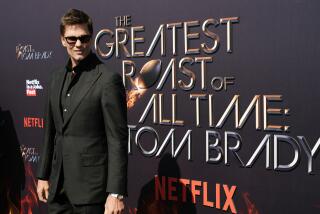NFL’s Best Players Sitting Close to Walls of Human Limits
NFL historians have noted a curious similarity about the only two meaningful football records set in New Orleans this month during Super Bowl XXXI:
* When Desmond Howard of Green Bay raced that New England kickoff 99 yards to make sure the Packers won, 35-21, he broke the Super Bowl’s kickoff-return record--by one yard.
* When the Packers went 81 yards on a first-half touchdown pass, Brett Favre to Antonio Freeman, they broke the record for longest Super Bowl play from scrimmage--by one yard.
In other words, the game’s best players are still doing historic things. But after three decades of Super Bowls, their big plays these days aren’t bigger by much.
And that will continue indefinitely, in the view of Harvard scientist Stephen Jay Gould, a paleontologist who also follows major league sports.
“Changes, if any, from now on are likely to be minute,” he predicts.
Mentioning Ted Williams’ 1941 batting average, .406, Gould turns to baseball to make an evolutionary point.
“There is a wall of human limitations--a boundary that nobody can get by,” he says. “And Williams, to take one example, brushed it that year.”
Author of “Full House,” a new book on the full range of life’s excellence, Gould discounts the usual explanations for the decline of .400 hitting--more night games, more travel and fewer good hitters--as irrelevant or wrong.
Stressing that .400 is about it for any batter, he continues:
“Nobody has hit .400 since Williams not because today’s ballplayers are inferior to Williams but because they’re better than ever.”
Thus they restrict and restrain one another.
In the NFL, too, Gould notes, the best 1990s players are better than in any previous decade.
But there are also more of them, he says, more good football players than ever. And that cancels any prospect for a barrage of significant Super Bowl records next year, or any year.
That is a paradox, clearly.
And to explain it, Gould, who puts Tony Gwynn, Wayne Boggs and other modern hitters in Williams’ class, again uses a baseball example:
“The disappearance of .400 hitting measures the game’s general improvement since Williams. Hitting has improved along with all other aspects of play. Fielding and relaying have improved dramatically.
“Fielders’ gloves were a joke in the early days. [Today] they scoop up grounders in gloves as big as brontosaurus’ footprint. At bat now, all hitters face fresh pitching arms in late innings. These and other changes rob great batters of 10 to 20 hits a year.”
And, at the same time, rob them of .400 seasons.
Similarly in football, defensive improvements inhibit extraordinary offensive performance. In fact, what’s happening now in all of the established sports, Gould says, is that the gap between the world’s best and second-best athletes is closing.
The great ones, he points out, “once soared far above the norm.” Today, the norm is higher. The average guys are catching up.
If the particulars are harder to see in a Super Bowl context, he suggests, it’s only because of the rule changing that in football is chronic.
But they’re there.
“It’s obvious that a man will never run 60 mph,” Gould says. “And in football, too, three decades after the first Super Bowl, the NFL’s best players are sitting closer to the wall of human limits.”
*
As the Super Bowls of the 20th century dwindle down to only a few more, what kinds of championship-day records are likely to survive into, at least, the 21st century?
Here, conceivably, are some of them:
--In 1987, New York Giant quarterback Phil Simms completed 22 of 25 passes against Denver, a completion percentage of .880.
--A year later, also against Denver, Washington Redskin quarterback Doug Williams threw four touchdown passes in one quarter.
--The Redskins scored 35 points in that quarter.
--In the 1995 Super Bowl, San Francisco and San Diego combined to score a record 10 touchdowns.
--For the 49ers that day, quarterback Steve Young threw six touchdown passes.
--In Super Bowl III, Tom Matte, on a 116-yard day for the old Baltimore Colts, rushed the ball for a 10.5-yard average. By comparison, Timmy Smith, on his 1988 record 204-yard day for Washington, averaged but 9.3.
--Terry Bradshaw averaged 14.71 yards passing against the Ram defense in 1980, the best performance in 31 Super Bowls.
--A year later, against Philadelphia, Rod Martin made all three of the Raiders’ interceptions in Super Bowl XV.
--A lineman, Leon Lett, holds the record for longest fumble return, 64 yards, for Dallas against Buffalo in 1993.
“Never say any record is unbreakable,” Gould says, speaking from his home in Cambridge, Mass. “When good athletes are competing year after year, no record is absolutely safe. But from now on, the Super Bowl’s measurable changes, if any, can be expected to measure in fractions only.”
*
At Harvard, where Gould’s field is evolutionary biology, he is the Alexander Agassiz professor of zoology and professor of geology. And in “Full House”(Harmony Publishing, $25), he rejects the thought that “humankind is the crowning achievement of evolution.”
Instead, he argues, Darwinian natural selection has simply prompted variations in the way life has developed and expanded in the last 3.5 billion years, “variations that are random and unpredictable.”
At one extreme edge of the expansion, Williams’ .406 batting average--baseball’s best in 56 years--is visible as, fundamentally, an aspect of human variation.
The science of hitting didn’t “progress” toward .406, Gould holds. In 1941, as the last of the century’s eight .400 hitters, Williams, like the others, simply distanced himself from the pack.
That year, so did Joe DiMaggio.
The Yankee Clipper’s 56-game hitting streak, which Gould calls “the greatest achievement in modern sports,” represents, statistically, the luck of the draw in a full house of potential human variation.
It’s a coincidence that DiMaggio and Williams peaked the same year.
*
One clear difference between the Super Bowl players of the 1960s and ‘90s is their size. In the offensive lines, they’re 100 pounds heavier now, reaching 330 or more. At other positions, they’re up 50 pounds or more.
Steadily, in fact, Americans have been getting taller and heavier, as the record books and history books all show.
Less than 150 years ago, during the Civil War, most Northern soldiers stood about 5-feet-2. Some of the most famous generals rose not much more than 5 feet. Although their president, Abraham Lincoln, came in at 6-4, his height was an aspect of human physiological variation. Or so students of the subject report.
In both Civil War armies, 90-pound soldiers were common.
Changes since then, nutritionists say, have been food-related for the most part, although athletes have also grown by lifting weights.
And the question is, will that trend continue? Will NFL games eventually be played by groups of 400-pounders? Will NBA games eventually be played not by 7-footers but 8-footers?
No chance, Gould replies.
“That isn’t my field, but I’m familiar with the data,” he says. “The tallest person who ever lived was nearly 9 feet tall but died at 29. He couldn’t even stand without a leg brace, and died of an infection in his leg that was caused by the brace.”
Exceptionally tall NBA candidates in recent years have tended to prove that coordination and mobility problems of an overwhelming nature set in at about 7 1/2 feet.
“The people in a couple of African groups stand 7 feet or more,” Gould says. “But most of them and [others] standing 7-5 or 7-6 find it just too hard to move.”
Excess weight also costs coordination and mobility.
“There comes a time when extra poundage is counterproductive,” Gould says. “For football linemen, I don’t think they know what the top is yet, but most say it’s certainly under 400 pounds.”
Research shows that NFL candidates exceeding 375 pounds and 6 1/2 feet tend to lose too much in movement and agility.
And one explanation is that those dimensions are too far above what has been the male optimum in both weight and height for at least the last 100,000 years.
Nutritional scientists involved in the research have said for a century or so that optimal male measurements have always been, and will always be, 200 pounds or less, more like 180, and about 6-feet-2.
Your ancestors, whatever their size, could have had those dimensions, they note, and your descendants, if nutritionally wise, will have them--always making allowances for human physiological variation.
The Super Bowl players of 2000 will be larger than this month’s, but not by much.
*
During Harvard lectures on human variation, as reflected in, among other things, Super Bowl performance and the ability to hit .400, Gould makes a distinction between natural or Darwinian evolution and what some improperly call cultural evolution.
“There’s a tendency to confuse the two,” he says, adding that cultural alteration is change, not evolution.
The size change in a blacksmith’s arm isn’t passed on to his son.
Moreover, cultural variables such as dedication and motivation ultimately affect performance as certainly as do genetic variables. A man born to hit .300 won’t get there without working at it.
In 1972, the 17-0 Miami Dolphins set a Super Bowl record that will last forever: fewest penalty yards, 0.
They worked at it.
By comparison, “some single-game Super Bowl records are clearly breakable,” Gould says.
Among them:
--Most rushing touchdowns, Marcus Allen and 10 others, 2.
--Most touchdowns scored, Ricky Watters and two others, 3.
--Most touchdown passes caught, Jerry Rice, 3.
--Most catches, Jerry Rice and Cincinnati’s Dan Ross, 11 apiece.
In the retelling, some of these records seem less than impressive. But what they demonstrate is how difficult it is to stand out above other professionals in a 31-year series.
On any one day, only Steve Young has been able to throw as many as six touchdown passes. After thousands of regular-season games, the NFL’s 77-year record is only seven.
For there are limits.
Among big-top trapeze artists, Gould says, the triple somersault is close to the human maximum. Only a handful of quadruples have ever been completed by those who lived to talk about it.
He submits that even in such disciplines as music, “the range of accessible styles is limited, perhaps exhausted.”
That may be the only way to explain the absence, since 1828, of any groups of geniuses to compare with Bach, Handel, Haydn, Mozart, Beethoven and Schubert, all of whom lived and worked between 1700 and 1828--an instant in the sweep of time.
“Many people of equal or greater potential talent must now be alive [in a much more populous world.] What are they doing?” Gould asks.
Similarly, what has happened to the musicians who might have added to the abundance of harmonious, melodious big-band music produced in 1935-50?
It could be that the artists of those times did it all, leaving popular music with only two places to go, rock and rap.
If, theoretically, more could be done, it can’t be much more. A wall of human limitation is out there.
Ted Williams saw it when he hit .406. Steve Young saw it when in one Super Bowl game he threw for six touchdowns. Great athletic achievement, Gould holds, is rarer than it sometimes seems. When it happens, enjoy it.
More to Read
Get our high school sports newsletter
Prep Rally is devoted to the SoCal high school sports experience, bringing you scores, stories and a behind-the-scenes look at what makes prep sports so popular.
You may occasionally receive promotional content from the Los Angeles Times.






